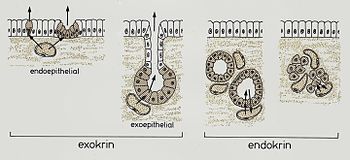gland
In anatomy, a gland ( Latin glandula ) is an organ that produces a (chemical) substance and is released via secretion (if it is used elsewhere in or on the body) or excretion (if it is to be excreted). Since the middle of the 19th century, for the first time by the French physiologist Claude Bernard , a distinction was made between internal secretion and external secretion.
Excretory glands
Excretory glands (also called exocrine glands ) deliver their secretion to an inner or outer surface of the body. They are often located in the connective tissue under the epithelium and are connected to it by an excretory duct. The origin of the duct is explained by the fact that these glands (for example sweat glands and salivary glands) are shifted from the surface of the epithelium in their embryonic development history and there differentiate into organs with the specialized epithelial cells typical for them , but with stay in contact with the original epithelial surface.
Incretory glands
Incretory glands (also called endocrine glands or hormone glands) develop like excretory glands starting from the surface epithelium, but here the connection is lost in the further course of development, so that there is no duct. Incretory glands (described by the anatomist and physiologist Johannes Müller as blood vessel glands , or blood glands for short) therefore release their secretion (also called incret) into the extracellular space . From there, hormones enter the bloodstream by diffusion . The entirety of these "inner secretory" glands (for example thyroid and pancreas) is called the endocrine system .
Web links
Individual evidence
- ↑ Lois Jovanovic, Genell J. Subak-Sharpe: Hormones. The medical manual for women. (Original edition: Hormones. The Woman's Answerbook. Atheneum, New York 1987) From the American by Margaret Auer, Kabel, Hamburg 1989, ISBN 3-8225-0100-X , p. 372.
- ^ Otto Westphal , Theodor Wieland , Heinrich Huebschmann: life regulator. Of hormones, vitamins, ferments and other active ingredients. Societäts-Verlag, Frankfurt am Main 1941 (= Frankfurter Bücher. Research and Life. Volume 1), in particular pp. 9–35 ( History of hormone research ), here: pp. 12 f. ( The glands ).
- ^ Otto Westphal, Theodor Wieland, Heinrich Huebschmann: life regulator. Of hormones, vitamins, ferments and other active ingredients. 1941, p. 12 f.
- ^ Otto Westphal, Theodor Wieland, Heinrich Huebschmann: life regulator. Of hormones, vitamins, ferments and other active ingredients. 1941, pp. 19-21.
